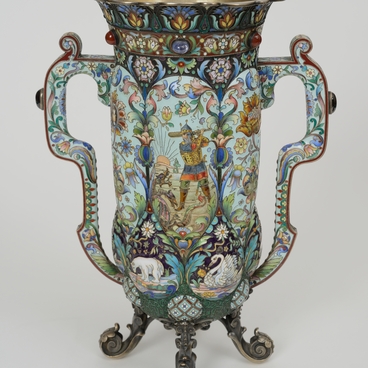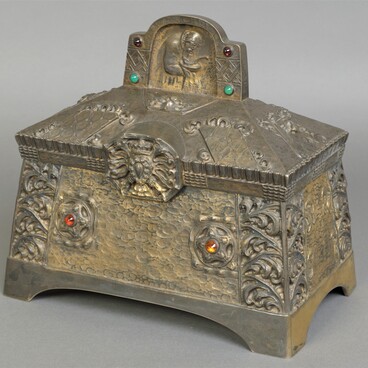Pavel Ovchinnikov’s company actively developed and popularized the ‘Russian style’ in jewelry. Ovchinnikov himself emerged from the serfs. He opened his small workshop in 1853, after 4 years of its work he was able to free himself from serfdom and became a merchant of the 3rd guild. He opened his own factory soon, which became one of the largest jewelry enterprises in Russia and has repeatedly become the official supplier of the Imperial Court. Many samples of Ovchinnikov’s work are kept in the State Historical Museum, museums and private collections in Russia and several European countries.
The chest presented in the exposition is one of the samples of the company’s products from the period of its heyday — 1870 — 1880s. The company’s craftsmen used various techniques, but Ovchinnikov was best known for chasing, casting and enamel. A variety of techniques were used — cloisonné, stained glass and painted polychrome enamels. When working with silver, the factory’s jewelers actively used blackening — the application of a mixture of silver, lead and copper sulfides to the base, due to which, after firing, a black pattern appears on the silver.
The success of Ovchinnikov’s business was due to the high technical and artistic level of the products manufactured by the company. It was he who first invited professional artists for cooperation. Over the years, Viktor Vasnetsov, Gustav Hartmann, Lev Dahl, Eugene Lanceray, Mikhail Mikeshin, Alexander Opekushin and other famous masters worked with him.
At the same time, the manufacturer understood the need to train highly qualified craftsmen. In 1875, he opened one of the largest professional schools in his industry at his factory of gold and silver products, whose students studied not only jewelry, but also general education subjects. At the factory, a two-story building was built, on the first floor of which there were workshops, on the second — a dormitory for 130 people. The studying terms ranged from 5 to 6 years.
Having existed for more than half a century, the jewelry company has made a huge contribution to the development of Russian gold and silver art. The activities of this company largely predetermined the rise of the domestic jewelry industry and its entry into the world art market.
The chest presented in the exposition is one of the samples of the company’s products from the period of its heyday — 1870 — 1880s. The company’s craftsmen used various techniques, but Ovchinnikov was best known for chasing, casting and enamel. A variety of techniques were used — cloisonné, stained glass and painted polychrome enamels. When working with silver, the factory’s jewelers actively used blackening — the application of a mixture of silver, lead and copper sulfides to the base, due to which, after firing, a black pattern appears on the silver.
The success of Ovchinnikov’s business was due to the high technical and artistic level of the products manufactured by the company. It was he who first invited professional artists for cooperation. Over the years, Viktor Vasnetsov, Gustav Hartmann, Lev Dahl, Eugene Lanceray, Mikhail Mikeshin, Alexander Opekushin and other famous masters worked with him.
At the same time, the manufacturer understood the need to train highly qualified craftsmen. In 1875, he opened one of the largest professional schools in his industry at his factory of gold and silver products, whose students studied not only jewelry, but also general education subjects. At the factory, a two-story building was built, on the first floor of which there were workshops, on the second — a dormitory for 130 people. The studying terms ranged from 5 to 6 years.
Having existed for more than half a century, the jewelry company has made a huge contribution to the development of Russian gold and silver art. The activities of this company largely predetermined the rise of the domestic jewelry industry and its entry into the world art market.



